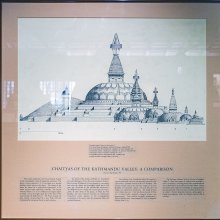Dharmadevacaitya, Dharmadeva-caitya, Dharmadevachaitya: 1 definition
Introduction:
Dharmadevacaitya means something in the history of ancient India. If you want to know the exact meaning, history, etymology or English translation of this term then check out the descriptions on this page. Add your comment or reference to a book if you want to contribute to this summary article.
Alternative spellings of this word include Dharmadevacaitya.
Images (photo gallery)
India history and geography
Source: Brill: Śaivism and the Tantric Traditions (history)Dharmadevacaitya (धर्मदेवचैत्य) is the name of an ancient monastery (in Kathmadu valley) named after Dharmadeva.—According to the Gopālarājavaṃśāvalī, the earliest local chronicle, the following monasteries and caitya were named after the donor: the Mānavihāra by Mānadeva, the Dharmadevacaitya by Dharmadeva, and the Devalavihāra by Devaladeva (Sanderson 2009, 74). The first one is confirmed by its mention in an undated inscription assigned to his reign (Sanderson 2009, 75). Several of the monasteries of the Kathmadu valley are attributed to kings of the period of the Ṭhākurī kings—most probably Kuladatta flourished in this period—in inscriptions, palm-leaf deeds, manuscript colophons, or their own tradition. But no monastery or caitya named after a king is reported (Sanderson 2009, 77–80).

The history of India traces the identification of countries, villages, towns and other regions of India, as well as mythology, zoology, royal dynasties, rulers, tribes, local festivities and traditions and regional languages. Ancient India enjoyed religious freedom and encourages the path of Dharma, a concept common to Buddhism, Hinduism, and Jainism.
See also (Relevant definitions)
Partial matches: Caitya, Dharmadeva.
Full-text: Dharmadeva, Manavihara, Devalavihara, Manadeva, Devaladeva.
Relevant text
No search results for Dharmadevacaitya, Dharmadeva-chaitya, Dharmadeva-caitya, Dharmadevachaitya, Dharmadeva-chhaitya; (plurals include: Dharmadevacaityas, chaityas, caityas, Dharmadevachaityas, chhaityas) in any book or story.
